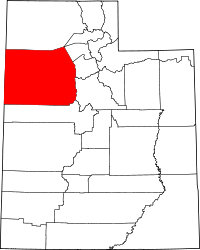Scranton, Utah
| Scranton | |
|---|---|
| Ghost town | |
 Scranton  Scranton Location of Scranton in Utah | |
| Coordinates: 40°2′56″N 112°12′3″W / 40.04889°N 112.20083°WCoordinates: 40°2′56″N 112°12′3″W / 40.04889°N 112.20083°W | |
| Country | United States |
| State | Utah |
| County | Tooele |
| Established | 1908 |
| Abandoned | c. 1918 |
| Named for | Scranton, Pennsylvania |
Scranton is a ghost town in Tooele County, Utah, United States. Located in Barlow Canyon near the Juab County line, it was a short-lived mining town. Scranton has been uninhabited for nearly a century, but some of its ruins have survived relatively intact.
History
Scranton was founded in 1908 around the New Bullion Mine, a lead and zinc mine.[1] It was part of the North Tintic Mining District, organized in 1902 for the area's silver, lead, and zinc mines. The new town became the home of the Scranton Mining and Smelting Company, the owners naming it after Scranton, Pennsylvania, their home town.[2]
Some 90 miners lived in Scranton, a few with families. The town included homes, a boarding house, general store/post office, and assay office. The large pocket of good ore at the New Bullion lasted only about two years, and the town began to dwindle.[1] Then in October 1914 a new company called the South Scranton was organized, and miners dug a long tunnel in search of other mineral resources. During World War I Scranton produced tungsten, sending it by insured parcel post due to its scarcity.[2] After the war the town quickly emptied.
Four old buildings remained in fine condition as late as 1971, when a brush fire ignited by a National Guard exercise burned two of them to the ground. The other two buildings and some mine equipment continue to mark the site of old Scranton.[1]
See also
References
- 1 2 3 Carr, Stephen L. (1986) [June 1972]. The Historical Guide to Utah Ghost Towns (3rd ed.). Salt Lake City: Western Epics. p. 33. ISBN 0-914740-30-X.
- 1 2 Blanthorn, Ouida (January 1998). A History of Tooele County (PDF). Utah Centennial County History Series. Salt Lake City: Utah State Historical Society. pp. 129–130. ISBN 0-913738-44-1. Retrieved July 15, 2012.
External links
- Scranton at GhostTowns.com
